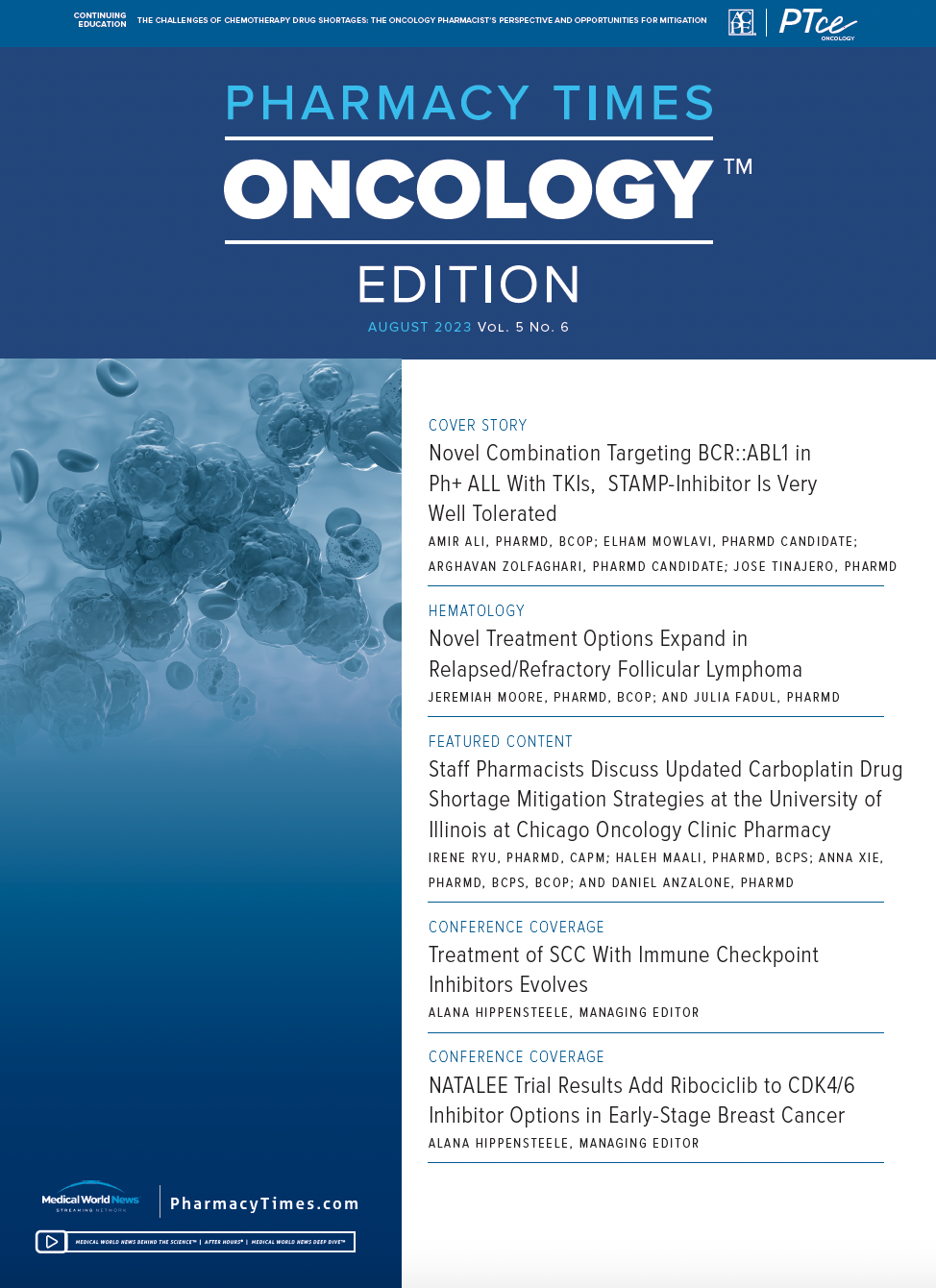Publication
Article
Pharmacy Practice in Focus: Oncology
Treatment of SCC With Immune Checkpoint Inhibitors Evolves
Author(s):
New data have resulted in updated guidelines for neoadjuvant cemiplimab.
Basal cell carcinoma (BCC) and squamous cell carcinoma (SCC) are the 2 most common cancers in the United States and patients have a very good prognosis, explained Heather Armbruster, PharmD, BCOP, during a session at the inaugural 2023 Pharmacy Times Continuing Education Oncology Pharmacists Connect conference in Austin, Texas. Armbruster explained further that the rate of metastatic disease with BCC is less than 0.1% and 5-year survival is approximately 100%. For SCC, the rate of metastatic disease is slightly higher, but 5-year survival is approximately 98%.
Credit: freshidea - stock.adobe.com

“However, even though the rate of metastasis is low with these cancers, there is the potential for that to cause substantial local destruction and disfigurement involving soft tissue cartilage and bone,” Armbruster, pharmacy manager in outpatient clinical services at The Ohio State University Comprehensive Cancer Center – Arthur G. James Cancer Hospital and Richard J. Solove Research Institute in Columbus, said during the session. “These cancers typically develop on areas of the skin that are exposed to radiation. So, with BCC, we can see it more after exposure to radiation therapy, and we can see both BCC and SCC occur after exposure to the sun and ultraviolet [UV] rays.” Specifically, radiation exposure risk factors for SCC and BCC can include exposure to UV-A and UV-B light; chronic exposure to UV light (SCC); indoor tanning; light skin, red/blond hair, and light eye color; and ionizing radiation and radiation treatment, especially at a young age (BCC).
“The other [risk factor] I want to point out is immunosuppression. So thinking about medications and also patients who have had prior solid organ transplants, as these are populations where we will commonly see these nonmelanoma skin cancers—when these cancers occur, there is a stratification system that factors in a number of characteristics to determine whether the risk for recurrence is low, high, or very high risk,” Armbruster said. “Based on these features and their presence, BCC either has low or high risk for recurrence. When looking at SCC, the risk is either low, high, or very high—and this will come into play as we look at our treatment strategies for managing these types of cancer.”
Overall, the goal for treatment of nonmelanoma skin cancers is complete tumor removal and maximal preservation of function and cosmesis, according to Armbruster. Surgery is the most effective and efficient means of accomplishing a cure; however, if surgery may not be the best option due to function, cosmesis, or patient preference, radiation therapy can work. More superficial low-risk tumors or surrounding in situ disease may also be treated with local topical therapies despite lower cure rates.
“Additionally, for patients at high risk for multiple primary tumors, they need to have increased surveillance and it may be appropriate to consider prophylactic measures, such as nicotinamide, for these patients,” Armbruster said. “Now, looking at our treatment strategies, this is where the risk stratification comes into play.”
For local, low-risk disease, the primary treatment modality is surgery. For patients who are nonsurgical candidates, radiation would be considered, explained Armbruster. For those more superficial, low-risk tumors, topical therapies can be considered. Additionally, when looking at the high- or very high-risk types of cancer, the primary option is surgery. For BCC, if surgery could cause significant functional damage, neoadjuvant vismodegib (Erivedge; Genentech) followed by peripheral and deep en face margin assessment may be considered (category 2B). For patients with SCC, adjuvant radiation therapy can be considered if there are poor prognostic features.
“Again, for those patients [who] are not surgical candidates, you’re going to need radiation therapy. There are data and recommendations for patients with SCC to add cytotoxic chemotherapy, as well for chemoradiation,” Armbruster said. “Then lastly, for patients who are not able to be cured with surgery or resection, this is where our systemic therapies come into play.”
For SCC systemic therapy that is not concurrent with radiation therapy, preferred regimens are immune checkpoint inhibitors (ICIs), and specifically cemiplimab-rwlc (Libtayo; Regeneron Pharmaceuticals) and pembrolizumab (Keytruda; Merck), or clinical trials, according to Armbruster. For patients who have progressed on or are not eligible for ICIs or clinical trials, the other recommended regimen is carboplatin with paclitaxel. Other regimens that can be useful in certain circumstances; these include neoadjuvant cemiplimab; EGFR inhibitor (eg, cetuximab [Erbitux; Lilly]); capecitabine; cisplatin with or without 5-fluorouracil; or carboplatin.
Starting with cemiplimab-rwlc for advanced SCC, Armbruster explained that the data to support its use in this setting come from a phase 2, nonrandomized, open label, multicenter trial (NCT02760498). The study included 2 groups: metastatic disease (group 1) or locally advanced (group 2) SCC.
“I do want to point out the exclusion criteria here that patients who have ongoing or recent substantial autoimmune disease or prior solid organ transplantation were excluded from the study,” Armbruster said. “In this trial, patients initially received 3 mg/kg IV [intravenously] every 2 weeks. This was later amended to the FDA-approved dose of 350 mg/kg IV every 3 weeks, and this treatment was continued for 96 weeks or until progression or intolerance.”
The primary objective of the trial was objective response rate (ORR), with secondary end points of duration of response (DOR), progression-free survival (PFS), overall survival (OS), and toxicity. The baseline characteristics of patients were a median age of 71 years in the metastatic arm and 74 years in the locally advanced arm, and most patients in both arms were male. The number of patients who received prior cancer-related radiation therapy was 54% in the metastatic group and 59% in the locally advanced group.
“In regard to efficacy outcomes, the ORR was 47% in the metastatic group and 44% in the local advanced group. Additionally, there are patients in both groups [who] obtained a complete response [4% in metastatic and 10% in locally advanced] and then an even larger percentage of patients [who] obtained a partial response [24% in both arms],” Armbruster said.
Additionally, median time to response was 2 months in both arms, and then a follow-up period of 8 months. The median DOR, median PFS, and median OS had not been reached in either group. Armbruster noted that overall, the study demonstrated a high ORR and durable responses.
“From an adverse effect [AE] perspective, the treatment-related AEs were consistent with what we’ve seen in other cemiplimab-rwlc and other anti–PD-1 inhibitor trials,” Armbruster said. “Grade 3 to 5 treatment-related AEs were 12% [in the metastatic arm] and 14% [in the locally advanced arm], with about 8% of the [locally advanced] patients and 7% [of the metastatic patients] having to discontinue treatment due to those AEs.”
There are also more recent 15-month follow-up data, Armbruster explained. At this follow-up point, the ORR increased further to the 50% range in all arms. However, the median DOR and median OS still had not been reached.
“So again, high durable responses with cemiplimab in this patient population, and no new or unexpected AEs,” Armbruster said. “So key takeaways from this trial were the median time to response of about 2 months across this study; there was similar efficacy in patients with both distant [49%] and regional [43%] metastases; and response was also not dependent on PD-L1 status.”
Armbruster explained further that the response rates were higher in patients who had PD-L1–positive disease, but that the response was seen regardless of PD-L1 status, showing that PD-L1 positivity is not a requirement for using cemiplimab in this indication. Further, she noted that broad ranges to tumor mutation burden were seen in responders and nonresponders. Based on these study findings, cemiplimab was fully approved by the FDA and is a preferred regimen for locally advanced or metastatic SCC that is not curable by surgery or radiation, Armbruster explained.
Pembrolizumab is the other preferred ICI therapy for advanced SCC; data for its use came from another phase 2, nonrandomized, global, multicenter study (NCT03284424) that had 2 groups. One was locally advanced and the other was recurrent or metastatic disease. In this trial, patients received pembrolizumab at 200 mg IV every 3 weeks, with a duration of 35 cycles or until progression or intolerance. The primary end point was ORR, and the secondary end points were DOR, PFS, OS, and safety and tolerability. “Here we saw similar baseline characteristics, with the median age in the 70s and the majority of patients were male,” Armbruster said. “Again, some of the patients had also received prior systemic therapy for their SCC.”
For efficacy outcomes, the ORR was 50% in the locally advanced group and 35% in the recurrent and metastatic group. There were also again patients with a complete response [17% and 11%, respectively] and a larger percentage with a partial response [33% and 25%, respectively]. The median time to response across the study was approximately 2 months.
At a follow-up period of 15 months in the locally advanced arm, the median DOR, median PFS, and median OS had not been reached. In the recurrent and metastatic arm, the median duration of response had not been reached.
“But we did have a median PFS of 6 months and a median OS of 24 months,” Armbruster said. “Again, here with this study, good and encouraging ORRs, complete and partial responses, and then again, seeing a durable response in those patients who do have a positive benefit from this medication.”
The AE profile of pembrolizumab also had a consistent toxicity profile with other anti–PD-1 inhibitors and pembrolizumab studies. Grade 3 to 5 treatment-related AEs occurred in about 12% of patients, with 9% of those patients having to discontinue treatment due to AEs.
Based on this study, the median time to response was 2 months in the overall cohort; the ORR was higher in the first-line setting vs patients who received it in the second line or beyond. Again, PD-L1 expression did correlate with an ORR, but response rates were seen regardless.
“So, PD-L1 positivity is not required for the use of pembrolizumab in this setting, and the toxicity profile was consistent with pembrolizumab in other trials,” Armbruster said. “Based on this study, pembrolizumab is fully approved and is a preferred regimen for locally advanced, recurrent, or metastatic SCC that is not curable by surgery or radiation.”
Armbruster noted that other ICI data to address for advanced SCC involve using cemiplima in the neoadjuvant setting for stage II to stage IV disease. In a recent study (NCT04154943), patients received cemiplimab in the form of 350 mg IV every 3 weeks for up to 4 doses.
“In regard to efficacy outcomes, you can see that 51% of patients obtained a pathological complete response, 13% obtained a pathological major response, and the overall [ORR] was 60%,” Armbruster said. “So very encouraging results from an efficacy standpoint. Part 2 of this trial is still ongoing, and that part of the study allowed for optional adjuvant cemiplimab, adjuvant radiation therapy, or observation. So, more data to come, but this is now an option listed in the guidelines when looking at using neoadjuvant cemiplimab in some settings prior to resection.”
Reference
Armbruster H. Non-melanoma skin cancers: the evolution of treatment with immune checkpoint inhibitors and its implications for oncology pharmacists. Presented at: 2023 Pharmacy Times Continuing Education Oncology Pharmacists Connect conference; June 16, 2023; Austin, TX.







